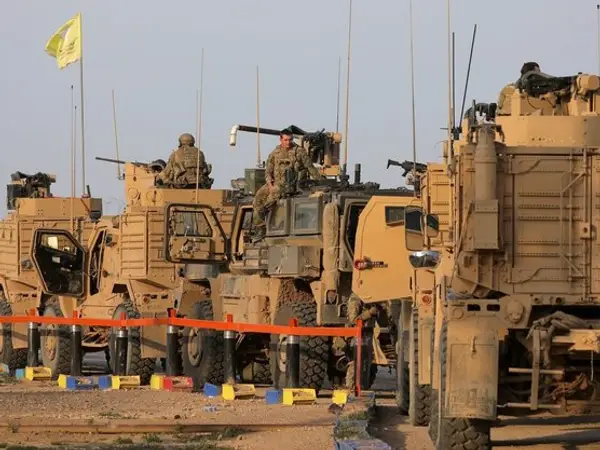Amid reports of movements by US forces in Syria and Iraq, the American military as well as Iraqi officials have refuted reports of a military build-up.
Asharq Al-Awsat cited Major General Yahya Rasool, the spokesman for the Commander-in-Chief of Iraq’s Armed Forces, who stated on Sunday that there are no US military movements, despite footage of US military convoys circulating in separate Iraqi locations as shown in local media.
There are unconfirmed reports in local media that the US has deployed additional military forces along the border between Iraq and Syria, possibly preparing for an operation against pro-Iran militias in eastern Syria. The aim would be to disrupt Iranian supply routes to Syria and Lebanon.
Khalid al-Yaqobi, the Security Policy Advisor to the Prime Minister of Iraq, denied reports of the US army increasing its military presence in Iraq, according to the Iraqi News Agency. He claimed that the recent large-scale troop movements are merely “replacements” for the US-led forces in neighboring Syria. Yaqobi stated during a televised interview on Sunday, "There is no mobilization of US forces, but rather a replacement for US units present in Syria."
Three Iraqi officials, including a leader of an armed faction stationed in northwestern Iraq, informed the London-based newspaper that the US was repositioning its troops in the region, possibly preparing for a military operation outside Iraq. Another Iraqi government official told Asharq Al-Awsat that the alleged movements “are limited to locations outside the Iraqi border.”
An unnamed militia leader, likely from the groups backed by Iran, noted that the armed factions believe the strategic objective of the operation was to “change the rules of engagement with the Russians in Syria.” He emphasized that “What we have now is just speculation, based on limited information, as the Americans do not share much with Baghdad about their operations.”
According to the Iraqi figures, “the Americans will also try to cut off the Iranian supply route towards Syria and Lebanon, through Iraqi territory... This is all we know so far.”
Asharq Al-Awsat claimed that factions known for their opposition to the US presence are maintaining calm over the recent US movements, a departure from their usual behavior.
A senior official from the Coordination Framework, a coalition of Shiite parties aligned with Iran, was cited by Asharq Al-Awsat as saying, “The faction leaders recently discussed information about the American moves and received an Iranian message that what the Americans are doing, whatever it is, is not a cause for concern.” Earlier reports said the Shiite factions are “aware of an imminent operation and have been asked to avoid escalation.”
The US-led Coalition to combat the Islamic State (ISIS) also rejected reports of the United States deploying more troops to Iraq, stating it is part of a normal rotation of foreign forces in the country.
Major General Matthew McFarlane, the outgoing Commander of the Combined Joint Task Force-Operation Inherent Resolve (CJTF-OIR), was quoted by Kurdistan 24 as saying during a press conference on Sunday, “I have seen those rumors; they are just rumors. We are in the middle of rotations right now, which are normal routine activities involving bringing in new units with equipment.”
He added, “These rotations are necessary so our troops stay fresh and connected to their families. There was a press release in March from the Department of Defense about it, pending changes.”
Pentagon Press Secretary Air Force Brig. Gen. Pat Ryder stated on August 17 that claims of US forces being engaged in border security between Iraq and Syria are not true, emphasizing that they do not provide such security.
However, Foreign Policy Analyst Walid Phares suggested on Sunday that Iran’s Revolutionary Guards have temporarily suspended attacks on US units in Iraq because American and allied forces are coming close to shutting down most of the Syria-Iraq border.
Over the past few days, American troops have reportedly dispatched armored vehicles and soldiers to the Syrian border, entering from the Iraqi side and positioning near the city of al-Qa’im, adjacent to the border town of Al Bukamal along the Euphrates River. The US-led coalition has also conducted military exercises involving fighter aircraft at the "Koniko" base located in the northern outskirts of Deir ez-Zor, Iraq's Shafaq News Agency reported.
Moreover, the political wing of Iraq's Asa'ib Ahl al-Haq (AAH), an Iranian-backed Shiite militant group led by Qais al-Khazali, said that around 2,500 US soldiers have recently entered Iraqi territory and are now stationed at the Ain al-Assad Air Base.
This deployment coincides with the presence of military vehicles and combat aircraft in the area. Earlier in August, Washington announced that more than 3,000 US sailors and marines have arrived in the Middle East, along with the USS Bataan (LHD 50), an amphibious assault ship, and the USS Carter Hall (LSD 50), a dock landing ship.
The forces from the Bataan Amphibious Ready Group (ARG) and 26th Marine Expeditionary Unit (MEU) have been deployed in response to escalating tensions with Iran and as a show of maritime strength. In June, the Pentagon had already sent additional F-35 and F-16 fighter jets along with a warship to the Middle East to monitor key waterways in the region following Iran's seizure and harassment of commercial vessels. Recent developments in the region, including Iran's seizure and harassment of vessels, have seen tensions rising.
Earlier this week, Iran’s Revolutionary Guard released a video of surveilling and following a US Navy ship in waters off the coast of the Strait of Hormuz in the Persian Gulf. IRGC commanders, such as commander-in-chief Hossein Salami, keep threatening the US forces in the region.
Apparently, the new deal between Tehran and Washington only focuses on a prisoner swap and Tehran’s frozen funds without reducing tensions between the US forces and Iran’s proxy militias, led by IRGC's extraterritorial Quds force.
